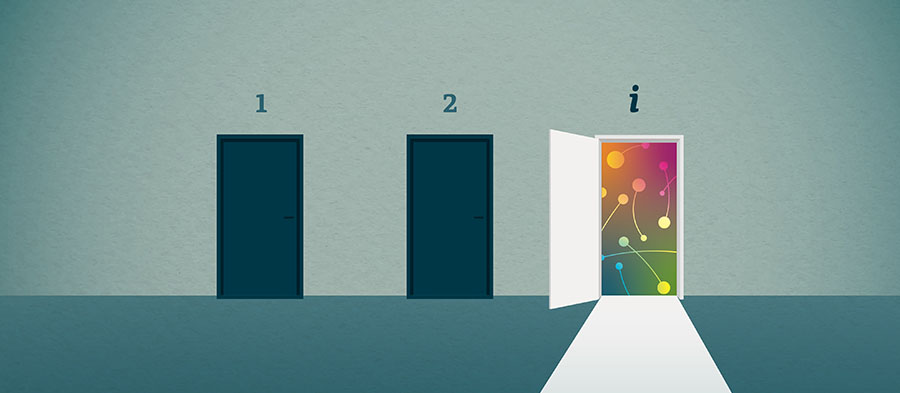
November 2022 (Volume 31, Number 10)
New Experiment Suggests Imaginary Numbers Must Be Part of Real Quantum Physics
A new experiment closes theoretical loopholes, strengthening the evidence that imaginary numbers play an irreplaceable role in quantum theory.
By Bailey Bedford | October 13, 2022

Credit: Elia King / APS
New research tightens the argument that imaginary numbers — denoted as i — are vital to quantum theory.
Since quantum mechanics’ inception nearly a century ago, there has been controversy about the math at the heart of the field: Does quantum theory require the use of imaginary numbers?
Imaginary numbers — numbers given in terms of the square root of negative one and that produce real numbers when multiplied together — are an important part of mathematics, but in physics, no observation has demanded their use. Until recently, it seemed like imaginary numbers in quantum physics calculations might make things easier, but be unnecessary.
A paper published September 26 in Physical Review Letters details an experiment that demonstrates that quantum mechanics formulations that utilize complex numbers — numbers with both real and imaginary pieces — can outperform formulations that exclusively use real numbers. The research closes some loopholes that might undermine the refutation of real-valued quantum mechanics, boosting the argument that imaginary numbers are vital to the field.
“I think it's a fundamental question to ask — the question whether a complex number is really necessary for quantum mechanics,” says Chao-Yang Lu, a physics professor at the University of Science and Technology of China and a co-author of the paper.
According to Lu, that question has remained mostly philosophical throughout quantum mechanics history. Then, in a 2021 paper in Nature, researchers “proposed an experiment that can actually put the philosophical argument into [a] test,” he explains. “You can see the test as a game between three players, Alice, Bob and Charlie.”
In that game, the three players receive quantum particles from two independent sources. Through a carefully orchestrated trick that hinges on the quantum property of entanglement, two players can find that their particles influence each other, despite never having directly interacted.
While playing the game can be complicated, the essence of the test is simpler: Complex and real number formulations bet on the outcome of several game rounds. Each formulation predicts a highest possible number for the correlation between the particles’ measured properties. The paper in Nature proved that for this quantum game, complex formulations, with the extra flexibility of imaginary numbers, will always predict a higher value than any real-valued formulation (as long as the formulations abide by certain rules that define foundational features of quantum mechanics).
The new experiment used photons, produced as entangled pairs, as the quantum particles. The resulting observations exceeded the constraint predicted by the real-valued formulation by 5.30 standard deviations, supporting the assertion that complex numbers are needed to make the best possible quantum predictions. This builds on similar conclusions reached by two experiments earlier this year, one of which involved Lu and other authors of the new paper. But all these tests had loopholes. In both previous tests, parts of the experiments were located close enough together that information might have passed between the players, which could alter what predictions are possible using only real numbers.
To close this loophole, called a locality loophole, the team spread the new experiment over five locations, each at least 89 meters apart, ensuring that information would need to travel from one part of the experiment to another faster than the speed of light to interfere with the results. This precaution, Lu says, was intended to help rule out the possibility that unknown mechanisms — at least, those allowed by the current laws of physics — would influence the experiment.
“The goal of this kind of experiment is to rule out a class of theory, and you haven't really done it if there are these loopholes remaining,” says William Wooters, an emeritus professor of physics at Williams College who was not involved in the paper. “It is good to close the loopholes.”
By ensuring events in the experiment happened quickly and far enough apart, the researchers say in the paper that, given reasonable assumptions, they have closed three loopholes: locality, independent source, and measurement independence.
Marc-Olivier Renou, a researcher at the Institute of Photonic Sciences in Spain, who was not involved in this research and was a co-lead author of the Nature paper, says that the important loophole of independent source can never be absolutely closed, but that, in the future, researchers might be able to quantify how much the loophole is closed.
“In this paper, they really formally and very clearly close the locality loophole,” says Renou. “But now you have a second loophole, which is always a matter of belief — you believe that in your experiment your two sources are independent, but there is no very absolute way to close it. … Someone could always say, ‘Oh, no, but actually the state is not created at this moment; it was created before that.’ And there is absolutely no way to rule out these kinds of explanations.”
In the new paper, the researchers acknowledge that, without making an assumption, “it is impossible to rule out all loopholes” because the particles’ correlations could result from “hidden variables” — some strange, unobserved hypothetical entities — that have existed since the birth of the universe.
The new experiment left open the detection loophole, which was closed in Lu and his colleague’s previous experiment. Lu says the team hopes to develop new techniques to enable an experiment that simultaneously closes the loopholes.
Bailey Bedford is a science journalist based in the Washington, D.C. area.
©1995 - 2024, AMERICAN PHYSICAL SOCIETY
APS encourages the redistribution of the materials included in this newspaper provided that attribution to the source is noted and the materials are not truncated or changed.
Editor: Taryn MacKinney
November 2022 (Volume 31, Number 10)
Articles in this Issue
